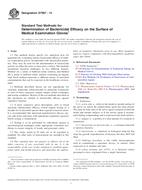Potřebujeme váš souhlas k využití jednotlivých dat, aby se vám mimo jiné mohly ukazovat informace týkající se vašich zájmů. Souhlas udělíte kliknutím na tlačítko „OK“.
ASTM D7907-14
Standard Test Methods for Determination of Bactericidal Efficacy on the Surface of Medical Examination Gloves
Automaticky přeložený název:
Standardní zkušební metody pro stanovení ničit bakterie na povrchu lékařského vyšetření rukavice
NORMA vydána dne 1.5.2014
Informace o normě:
Označení normy: ASTM D7907-14
Poznámka: NEPLATNÁ
Datum vydání normy: 1.5.2014
Kód zboží: NS-39271
Počet stran: 8
Přibližná hmotnost: 24 g (0.05 liber)
Země: Americká technická norma
Kategorie: Technické normy ASTM
Kategorie - podobné normy:
Anotace textu normy ASTM D7907-14 :
Keywords:
antibacterial, antimicrobial, bactericidal, bacteriocidal, biocidal, exam glove, examination glove, gloves, medical, medical glove, organic load, surface active, ICS Number Code 11.140 (Hospital equipment)
Doplňující informace
| Significance and Use | ||||||||
|
4.1 In the course of patient care, gloves of healthcare providers are often contaminated with microorganisms. This may occur when they come in direct or indirect contact with contaminated skin, oozing wounds, respiratory droplets, blood, amniotic fluid, saliva, or other potentially infectious materials (OPIM). It has been demonstrated that several bacteria known to be nosocomial pathogens, can survive for days, weeks and even months on surfaces that are touched by gloved hands. The presence of an effective antibacterial treatment on or in the glove that can rapidly reduce the number of viable bacteria on its surface, may also decrease the number of bacteria transferred from a contaminated source (reservoir) to a vulnerable patient or naïve site. These test methods enable assessment of bactericidal efficacy against a broad spectrum of bacteria and conditions, providing a means of efficacy comparisons for manufacturers, purchasers and users. 4.2 Four specific bacteria are listed to enable inter- and intra- laboratory test calibration and to provide common targets against which to compare antibacterial efficacy among products. 4.3 Manufacturers may additionally develop their own list of bacteria against which they will evaluate their products reflecting the circumstances in which their product will be used, the requirements set forth by the various agencies with which they are regulated, and the claims they are seeking. Alterations in test parameters must be validated and documented. |
||||||||
| 1. Scope | ||||||||
|
1.1 The methods herein specify two analytical tests for quantitatively evaluating surface bactericidal efficacy of medical examination gloves incorporated with bactericidal properties. They may be used for the determination of bactericidal activity on either the outer or inner glove surface. The methods incorporate bacterial challenges in two different formats: Method (A) a saline or buffered saline solution, and Method (B) a saline or buffered saline solution containing an organic load. Each method represents a different means of microbial contamination that can be expected in the healthcare environment. 1.2 Methods described herein are not appropriate for virucidal, fungicidal, tuberculocidal or sporicidal evaluations as each of these categories require unique culture techniques and testing conditions. Results of the test methods described in this document are limited to bactericidal efficacy against vegetative bacteria. 1.3 A more expansive glove description, such as broad spectrum antimicrobial efficacy, would require testing of a broader list of microbial species than vegetative bacteria alone. It is recommended that interested manufacturers discuss species and strain selections with appropriate regulatory agencies before testing is commenced. 1.4 Testing is to be performed by individuals trained in microbiological techniques under appropriate controlled conditions to ensure integrity of results and personnel safety. 1.5 The values stated in SI units are to be regarded as standard. No other units of measurement are included in this standard. 1.6 This standard does not purport to address all of the safety concerns, if any, associated with its use. It is the responsibility of the user of this standard to establish appropriate safety and health practices and determine the applicability of regulatory limitations prior to use. Most regulatory agencies require compliance with Biocompatibility guidelines under ISO 10993. |
||||||||
| 2. Referenced Documents | ||||||||
|




 Cookies
Cookies
